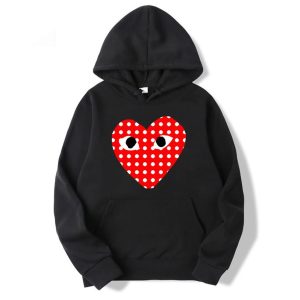When Rei Kawakubo founded Comme des Garçons in Tokyo in 1969, few could have predicted the seismic impact her vision would have on global fashion. Rooted in rebellion against traditional aesthetics, the label quickly grew into a phenomenon that challenged the definitions of beauty, structure, and luxury. By the time Kawakubo brought her collections to Paris in the early 1980s, the fashion world was forced to reckon with a new avant-garde language that favored asymmetry, deconstruction, and bold experimentation. While Paris became the stage for Comme des Garçons ’ international recognition, Germany would soon emerge as an unexpected yet influential hub for the brand’s cultural and commercial journey.
Germany’s Unique Relationship with Avant-Garde Fashion
Germany has long nurtured a cultural identity that values intellectualism, artistic experimentation, and subcultural resistance. From the Bauhaus movement of the early twentieth century to Berlin’s post-reunification underground art scene, the country has consistently provided fertile ground for radical ideas in design. This cultural context made Germany an ideal audience for Comme des Garçons, a brand that has never conformed to conventional fashion norms. Germans, particularly in cities like Berlin, have shown a strong appreciation for clothing that is more than just fabric—it is a statement, an artwork, and often a provocation.
Berlin as the European Playground of Rebellion
Berlin, with its raw creative energy and its reputation as a city of reinvention, became a natural partner in Comme des Garçons’ European journey. The city’s fashion scene is deeply intertwined with counterculture, from punk and techno to queer expression. Comme des Garçons, with its unapologetic disruption of silhouettes and its rejection of mainstream beauty standards, aligned seamlessly with Berlin’s ethos. For many German fashion enthusiasts, wearing Comme des Garçons became not simply a matter of style but a form of resistance and individuality.
Berlin’s boutiques and concept stores quickly recognized this resonance. High-end shops began carrying Comme des Garçons collections, presenting them not just as fashion but as cultural artifacts. In a city where nightclubs often feel like performance spaces and personal style is a political statement, the Japanese label fit effortlessly into the fabric of Berlin’s identity.
Comme des Garçons and German Minimalism
Although Kawakubo’s work is often described as radical and chaotic, there is also a subtle minimalism that runs through many of her designs. Germany’s cultural history has a strong connection with minimalism, whether in architecture, design, or philosophy. The Bauhaus movement’s emphasis on form and function, stripped of unnecessary ornamentation, parallels the quiet discipline often found in Comme des Garçons’ work. Even in its most avant-garde forms, Kawakubo’s vision maintains a certain purity that resonates with German aesthetics.
This philosophical overlap has made Germany one of the most receptive European markets for Comme des Garçons. Fashion students and designers in Berlin and Hamburg frequently cite Kawakubo as an inspiration, not just for her visual language but for her fearless approach to innovation. The brand’s presence in Germany has therefore been more than commercial—it has influenced the creative development of a generation of German designers who aim to merge art and fashion in equally radical ways.
Collaborations and Cultural Crossover
Comme des Garçons’ German journey has also been shaped by collaboration. The brand’s ability to cross disciplines—working with artists, musicians, and designers—has found a special echo in Germany, a country that thrives on cross-pollination between art forms. Berlin’s music scene, for instance, has seen DJs and electronic producers adopting the brand’s clothing as part of their stage identity. At the same time, visual artists in Germany have incorporated Comme des Garçons’ philosophy into exhibitions that blur the boundaries between fashion and art.
The label’s more commercial collaborations, such as those with sportswear giants, have also been particularly well received in Germany. The blending of streetwear with avant-garde design reflects the eclectic nature of German style, where practicality often meets artistic expression. These collaborations have expanded Comme des Garçons’ audience beyond the niche of high fashion, introducing the brand to younger generations across German cities.
The Role of German Celebrities and Influencers
Another key factor in the brand’s cultural integration has been the embrace by German celebrities, artists, and cultural figures. Musicians, actors, and fashion influencers have often chosen Comme des Garçons for public appearances, music videos, and red-carpet events. Unlike in some countries where celebrity endorsements are largely about glamour, in Germany these moments often highlight the intellectual and subversive qualities of the brand. The message is clear: Comme des Garçons is not just about looking different—it is about thinking differently.
Social media has amplified this influence. German influencers on Instagram and TikTok frequently showcase the label, contextualizing it within Berlin’s underground culture or Munich’s more refined fashion scene. In doing so, they have helped bridge the gap between Comme des Garçons’ high-concept identity and the everyday consumer who wants to align with its ethos.
Germany as a Stage for Global Expansion
Germany’s central location in Europe has also played a strategic role in Comme des Garçons’ growth. Berlin Fashion Week and other German fashion events provide platforms where international designers intersect with local talent and buyers. Comme des Garçons has used these opportunities to strengthen its presence and demonstrate how Japanese avant-garde can thrive in a European setting. Germany’s large and diverse consumer base, combined with its reputation as a cultural crossroads, makes it an essential part of the brand’s European strategy.
Challenges and Opportunities
Despite its success, Comme des Garçons has faced challenges in Germany. The brand’s experimental nature sometimes clashes with the more practical side of German fashion consumption, where durability and utility are highly valued. High price points can also limit accessibility, confining the label to elite circles. Yet, these challenges have also created opportunities. By introducing diffusion lines and more accessible collaborations, Comme des Garçons has been able to engage with wider audiences without diluting its avant-garde spirit.
The Future of Comme des Garçons in Germany
Looking ahead, Germany will likely continue to be a key space for Comme des Garçons’ evolution. As sustainability becomes central to German fashion discourse, the brand’s longstanding commitment to unconventional production methods may find new relevance. Kawakubo’s focus on timeless, seasonless concepts aligns with the growing German rejection of fast fashion. Moreover, the next generation of German designers, many of whom cite Comme des Garçons as inspiration, ensures that the brand’s legacy will remain deeply intertwined with the country’s fashion culture.
Conclusion: A Dialogue Between Cultures
The journey of Comme des Garçons from Tokyo to Berlin represents more than a geographical expansion—it reflects a dialogue between two cultures committed to artistic experimentation and resistance to conformity. In Germany, the brand has found an audience that not only CDG Hoodie appreciates its aesthetic but also understands its philosophical depth. From Berlin’s underground clubs to high fashion runways, Comme des Garçons has become a part of Germany’s cultural fabric. Its story in Germany is not just one of commercial success but of shared values, creativity, and the relentless pursuit of reimagining what fashion can be.





